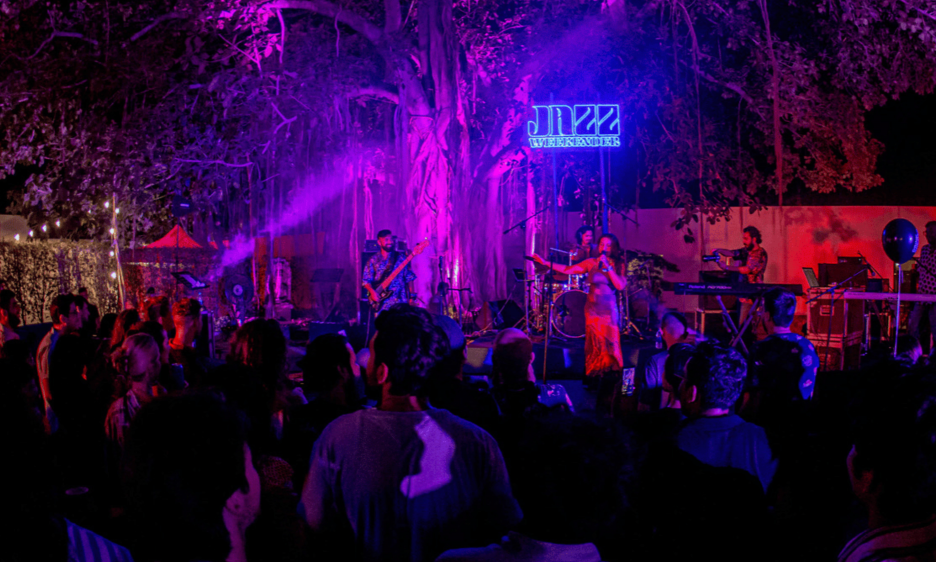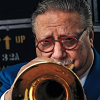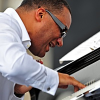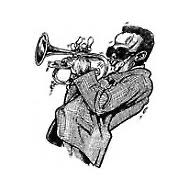Our Terms & Conditions | Our Privacy Policy
How Festivals Are Reviving Jazz All Around India article @ All About Jazz
Home »
Jazz Articles » Jazz In South Asia » The Big Stage: How Festivals Are Reviving Jazz All Around India

The live music scene in India is flourishing, and jazz is riding the tide. A recent Ernst & Young study estimates that the live music sector in India reached a value of around USD 1.4 billion in 2024 and is predicted to increase 20% yearly. With Gen Z and millennials making approximately 90% of all live event attendance in 2023, India’s younger population is clearly driving this increase -unsurprisingly.
India has long been known as a land of festivals; religion, food, film, literature, and musiccelebrated intensely by different communities but shared yet in a spirit of shared harmony. From the massive religious “Kumbh Mela” attended by hundreds of millions of people to regional arts festivals like Jaipur Literature Festival or Sunburn attended by tens of thousands, live events form a vital part of the country’s social fabric. Music festivals in particular have exploded in the past two decades, with indie, electronic, and fusion acts finding enthusiastic multi-generational audiences. Within this broader landscape, jazz is carving its own niche rooted in connection, exploration, and musicianship.
Electronic, metal, and indie music have emerged as some of the most vibrant and youth-driven genres in India’s festival landscape. Magnetic Fields, set against the other-wordly backdrop of Alsisar Mahal in the desserts of Rajasthan, is widely regarded as India’s most cutting-edge electronic music festival. On the opposite end of the sonic spectrum, Bangalore Open Air has carved out a loyal following among metalheads. NH7 Weekender, with editions across multiple cities, has become a launchpad for India’s indie and alternative acts, blending rock, pop, hip-hop, and experimental music into a high-production, mainstream-facing experience. Meanwhile, in the northeast, the Ziro Festival of Music offers a more grassroots counterpoint set in the lush hills of Arunachal Pradesh, it brings together indie, folk, and experimental artists in an intimate, eco-conscious setting. Together, these festivals showcase how non-Bollywood music scenes in India are thriving.
Global artists including Coldplay, Dua Lipa, Maroon 5, more jazz-adjacent musicians like 
Jacob Collier
vocals
b.1994
”
data-original-title=”” title=””>Jacob Collier,  ”
”
data-original-title=”” title=””>Cory Wong, and of course legends and rising stars like 
Herbie Hancock
piano
b.1940″
data-original-title=”” title=””>Herbie Hancock, 
Arturo Sandoval
trumpet
b.1949″
data-original-title=”” title=””>Arturo Sandoval, 
Kamasi Washington
saxophone
b.1981″
data-original-title=”” title=””>Kamasi Washington and  ”
”
data-original-title=”” title=””>Veronica Swift now view India as a major stop on international tours, thanks to this economic and cultural momentum. Jazz events all throughout India find rich ground here, venues reflecting and supporting the growing ecology. The post-pandemic era has been particularly explosive for live music in India as Youtube, Spotify and similar Indian platforms have on one hand, generated a viral interest in regional music and artists, and on the other, broadened the pool of music presented to the Indian audience via playlisting.
Legacy & Lift-Off: How Jazz Festivals Found Root in Bombay and Beyond
India’s jazz festival story begins in Mumbai, where Jazz Yatra, launched in 1978 by Niranjan Jhaveri, introduced audiences to global legends like 
Sonny Rollins
saxophone
b.1930″
data-original-title=”” title=””>Sonny Rollins and ushered in an era of large-scale live jazz. The festival eventually evolved into Jazz Utsav, now hosted annually in New Delhi by Capital Jazz.
Mumbai remains central to the country’s jazz landscape. The Mahindra Blues Festival, launched in 2011, while rooted in the blues, consistently invites jazzadjacent artists whose performances span soul, funk, and jazz. Alongside it, the NCPA International Jazz Festival at the Tata Theatre hosts some of the most globally respected names in the genre, such as 
Gonzalo Rubalcaba
piano
b.1963″
data-original-title=”” title=””>Gonzalo Rubalcaba and  ”
”
data-original-title=”” title=””>Veronica Swiftmaking it a key destination for serious jazz audiences.
In the north, Giants of Jazz, hosted by The Piano Man Jazz Clubs in metropolitan Delhi, has emerged as one of the country’s most consistent artist-focused festivals, featuring Indian and international performers in an intimate setting that prioritizes deep listening.
Bringing a more contemporary and high-energy approach is the Jazz India Circuit, organized by Teamwork Arts. With editions in cities like Gurugram and Goa, the festival highlights experimental and modern jazz voices, often bridging jazz, and world music in a lifestyle-forward format.
Together, these festivals, old and new, form a growing national circuit. They reflect not only the geographic spread of jazz culture across India, but also its evolution: from more elite stages to diverse, inclusive platforms that connect global influences with homegrown creativity.
Widening the Map: India’s Decentralized Festival Scene and International Jazz Day
April 30, UNESCO’s International Jazz Day, has subtly expanded the audience for jazz outside of India’s main urban venues. Cities including Goa, Kolkata, Chennai, Bangalore and Hyderabad today organize yearly events ranging from jam sessions and visiting artist performances to student presentations and seminars. These are events in community venues, music schools, and independent venues not sleek arena shows.
As mentioned before the emphasis is on connection between generations, forms, local and global musicians. One of the integral factors in this emerging jazz scene has been the role of visiting artists particularly from Western, Eastern Europe who travel across South Asia, leaving a legacy of collaboration and transfer of knowledge and repertoire in their journeys -we might explore some of these incredible musicians and their contributions in a later feature.
Goa has emerged as a particularly active node, with institutions like The Goa Jazz Academy organizing educational and performance-driven programming and inviting musicians from the US and Europe to play with and teach local musicians. In Kolkata, the Kolkata Jazz Festival has helped reconnect the city with its historic jazz roots (for more on the history of jazz in India, please check out Naresh Fernandes’ book, “Taj Mahal Foxtrot,” mentioned in the previous article in this series).
Meanwhile, boutique festivals like the Jazz Weekender, organized by Wild City and Gatecrash, held in Delhi are bringing jazz to new and younger audiences. Together, these developments signal a shift: jazz is no longer confined to elite circuits but is being reclaimed as a dynamic, regionally grounded form of expression.
In our next installment, we will explore jazz as an emerging subculture in India -from listening rooms, to bars, radio and more…
Tags
PREVIOUS / NEXT
Support All About Jazz

All About Jazz has been a pillar of jazz since 1995, championing it as an art form and, more importantly, supporting the musicians who make it. Our enduring commitment has made “AAJ” one of the most culturally important websites of its kind, read by hundreds of thousands of fans, musicians and industry figures every month.
Go Ad Free!
To maintain our platform while developing new means to foster jazz discovery and connectivity, we need your help. You can become a sustaining member for as little as $20 and in return, we’ll immediately hide those pesky ads plus provide access to future articles for a full year. This winning combination vastly improves your AAJ experience and allow us to vigorously build on the pioneering work we first started in 1995. So enjoy an ad-free AAJ experience and help us remain a positive beacon for jazz by making a donation today.
Near
[ad_1]
Images are for reference only.Images and contents gathered automatic from google or 3rd party sources.All rights on the images and contents are with their legal original owners.
[ad_2]



Comments are closed.